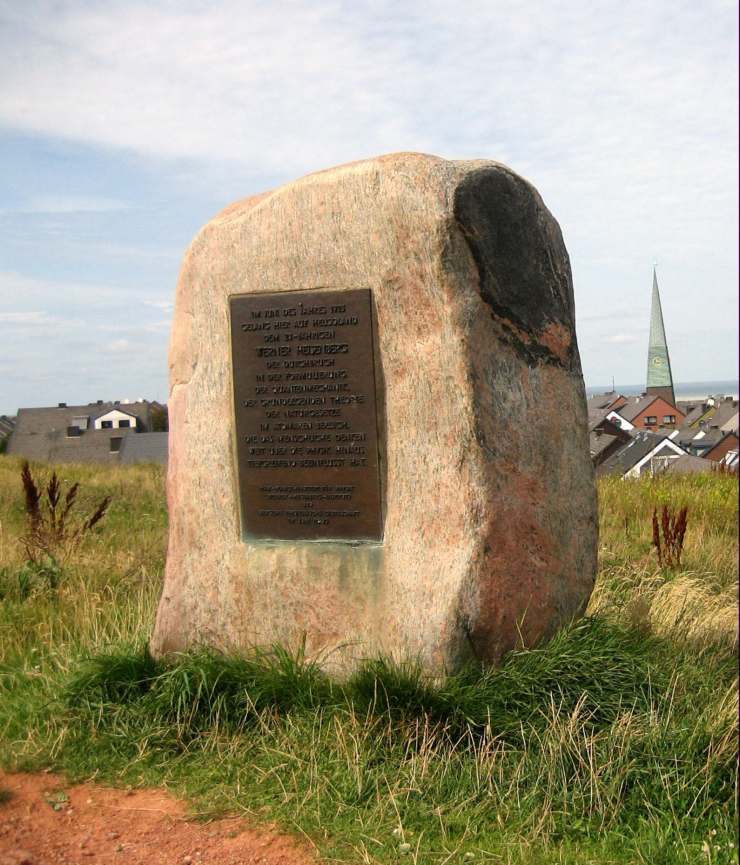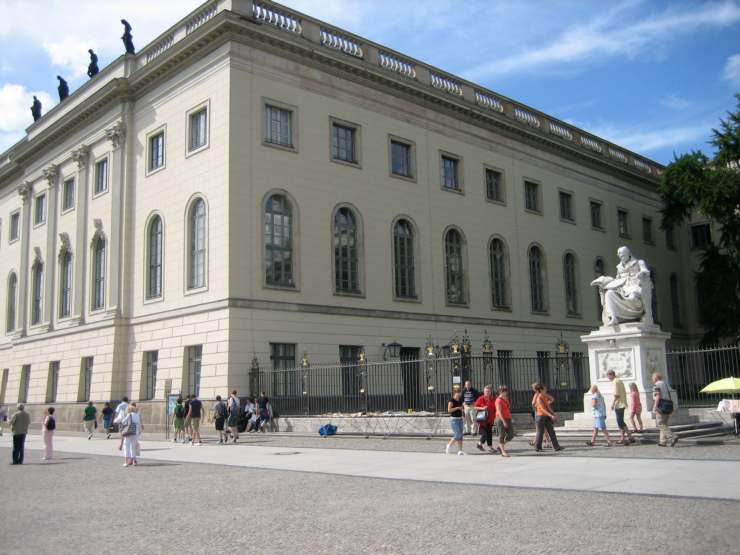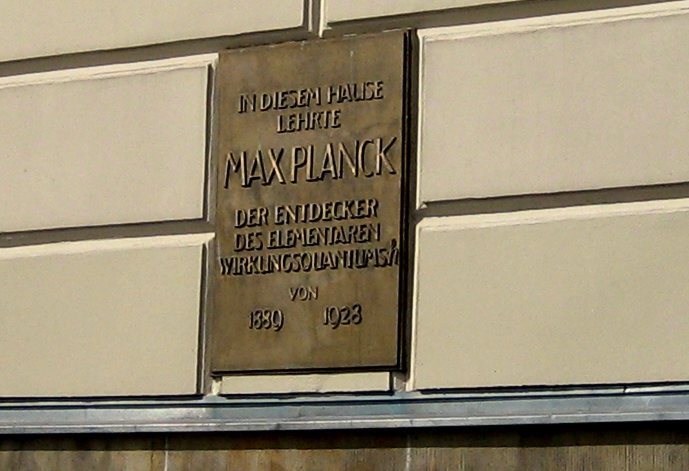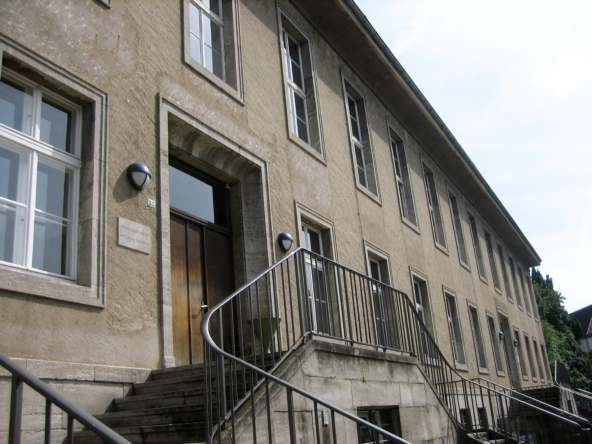Documents
1. On July 1925 the 23 years old Heisenberg visited the German island Helgoland. The result of this stay was a manuscript on "Quantummechanical reinterpretation of kinematic and mechanical relations". This paper now counts as the breakthrough that quickly led to the first complete formulation of quantum mechanics. Heisenberg wrote about this time:"In Helgoland war ein Augenblick, in dem es mir wie eine Erleuchtung kam, als ich sah, daß die Energie (gemeint ist die Energie eines einfachen Atommodells) zeitlich konstant war. Es war ziemlich spät in der Nacht. Ich rechnete es mühsam aus, und es stimmte. Da bin ich auf einen Felsen gestiegen und habe den Sonnenaufgang gesehen und war glücklich."

Im Juni des Jahres 1925
gelang hier auf Helgoland
dem 23-jährigen
Werner Heisenberg
der Durchbruch
in der Formulierung
der Quantenmechanik,
der grundlegenden Theorie
der Naturgesetze
im atomaren Bereich,
die das menschliche Denken
weit über die Physik hinaus
tiefgreifend beeinflußt hat.
Max-Planck-Institut
für Physik
(Werner-Heisenberg-Institut)
und
Deutsche Physikalische Gesellschaft
im Juni 2000
TH
This epoch-making paper is generally regarded as being difficult to follow. For example, Weinberg has written:
"If the reader is mystified at what Heisenberg was doing, he or she is not alone. I have tried several times to read the paper that Heisenberg wrote on returning from Helgoland, and, although I think I understand quantum mechanics, I have never understood Heisenberg’s motivations for the mathematical steps in his paper. Theoretical physicists in their most successful work tend to play one of two roles: they are either ... It is usually not difficult to understand the papers of sage physicists, but the papers of magician-physicists are often incomprehensible. In this sense, Heisenberg’s 1925 paper was pure magic."
2. Max Planck, Werner Heisenberg, Erwin Schrödinger, Max Born, Wolfgang Pauli, Niels Bohr, Pasqual Jordan, and other pioneers of quantum theory didn't see it as unserious to transcendent basic ideas of quantum theory to other domains such as the mind body problem, the issue of consciousness, questions of memory and perception, and even fields such as religion and ethics.


Humboldt University Berlin, where Max Planck taught from 1889-1928
For instance, in his famous farewell lecture "Scheinprobleme der Wissenschaft" (Göttingen, June 17, 1946), Planck addressed the mind body problem and argued against any form of a reductionist solution making crucially use of the idea of complementarity:
"Es ist daher nicht möglich, von einem einheitlichen Standpunkt aus sowohl die körperlichen als auch seelischen Vorgänge zu überschauen, und da man, um zu einem klaren Resultat zu gelangen, den einmal eingenommenen Standpunkt, der den anderen ausschließt, festhalten muss, so verliert die Frage nach dem Zusammenhang der körperlichen und der seelischen Vorgänge ihren Sinn." (p. 19).


In this connection the recent dispute between 11 Max Planck directors and 11 members of the Leibnitz Societät may be of interest.
Likewise, in his book "Geist und Materie" Schrödinger argued against the "bancrupters of rationalism" (chapter 3) making use of similar ideas, and in the same book he discussed the physical basics of consciousness (chapter 1).
Heisenberg discussed in a series of papers the relationship between words of our natural language and the meaning of the expressed concepts. (Diskussion über die Sprache, Sprache und Wirklichkeit in der modernen Physik, Die Kopenhager Deutung der Quantentheorie, Philosophie und Quantentheorie)
3. With the rise of cognitive science in the seventies and eighties of the last century, several physicists started to apply parts of the formalism of quantum theory to some puzzles of cognitive science including a proper modelling of natural concepts and prototypes, cognitive measures such as salience, typicality and cue validity, the phenomenon of ambiguity and bistability, the phenomenon of superposition and interference in perception and memory, and the phenomenon of mental timing. For a long time, pioneer workers such as Aerts, Gabora, Geissler, Khrennikov, Atmanspacher, Conte, Primas and others who worked in relative isolation and didn't win recognition of significant parts of the cognitive science community. The situation has changed within the last few years and more and more researchers realize the fascinating horizons that ideas from quantum theory open for cognitive science including artificial intelligence and theoretical linguistics.
4. Possibly it is superfluous to speculate about the reasons of this ignorance. Surely, it has to do with the facts that the early pioneers were magician-physicists who were not interested in being popular. Another more surprising aspect is that most psychologists, linguists, philosophers of mind and even researchers in traditional AI were not willing (or able) to learn the basics of linear algebra, a conditio sine qua none for being able to understand quantum theory.
Documents in alphabetical order
- Thomas Bock et al.: Nur ein Scheinproblem: Zu den erkenntnistheore-tischen Prämissen der Neurowissenschaften (2004)
- Werner Heisenberg: Quantummechanical reinterpretation of kinematic and mechanical relations (1925)
- Werner Heisenberg: Der Teil und das Ganze - Gespräche im Umkreis der Atomphysik (1981).
- Werner Heisenberg: Physik und Philosophie (1984)
- Hannah Monyer et al.: Das Manifest–Elf führende Neurowissenschaftler über Gegenwart und Zukunft der Hirnforschung. Gehirn und Geist 6: 30–37 (2004)
- Max Planck: Scheinprobleme der Wissenschaft (Vortrag, gehalten in Göttingen am 17. Juni 1946)
- Erwin Schrödinger: Geist und Materie (1978)